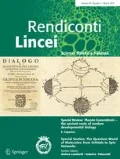Abstract
The Amundsen-Nobile Climate Change Tower (CCT) is one of the important scientific platforms operating in Ny-Ålesund, Svalbard. The CCT is equipped with a consistent set of meteorological sensors installed at different heights to provide continuous measurements of the atmospheric parameters that affect the climate and its variability. In this paper, some features of the main meteorological parameters observed during the 6 years of measurements since November 2009 are presented in order to describe the thermodynamic characteristic of the lower layers of the atmosphere and the peculiarities of CCT. Monthly and seasonal behavior of temperature, humidity and wind as well as radiation budget and albedo variability are also shown. Such preliminary statistical description aims to provide an overview of the phenomenology occurring in the Kongsfjord area, useful to proceed with further analysis of the arctic climatic system. Even if the time series are not long enough to consider the parameters variability on a climatological time scale, useful assumptions can be made for detailed analysis concerning turbulence studies, data intercomparison at different time and space scales, validation of theory and numerical model results. CCT dataset is stored in a dedicated built-in digital infrastructure that allows other users, in the frame of international cooperations, to visualize, access and download the data and contribute to strengthen the collaboration within the scientific community operating in Svalbard.





Similar content being viewed by others
References
Argentini S, Serraval R, Viola A, Mastrantonio G, Lupkes C, Petenko I, Pirazzini R (2000) Proc. 14th symposium on boundary layer and turbulence (Snowmass Village, Aspen, CO, 7–11 August 2000) pp. 602–605
Beine HJ, Argentini S, Maurizi A, Mastrantonio G, Viola A (2001) The local wind field at Ny-Ålesund and the Zeppelin mountain at Svalbard. Meteorol Atmospheric Phys 78(1–2):107–113. doi:10.1007/s007030170009. URL: http://dx.doi. org/10.1007/s007030170009
Boville BA, Gent PR (1998) The NCAR Climate System Model, version one. Journal of Climate 11(6):1115–1130. doi:10.1175/1520-0442(1998)0111115:TNCSMV2.0.CO;2
Bowles D, O’Connell P (1991) Recent advances in the modeling of hydrologic systems. Kluwer Academic Publishers, Nato ASI series
Curry JA, Schramm JL, Ebert EE (1995) Sea ice-albedo climate feedback mechanism. J Clim 8(2):240–247. doi:10.1175/1520-0442. URL:http://dx.doi.org/10.1175/1520-0442(1995)0080240
Dürr B, Philipona R (2004) Automatic cloud amount detection by surface longwave downward radiation measurements. J Geophys Res Atmos 109:D5, n/a–n/a. doi:10.1029/2003JD004182. URL:http://dx.doi.org/10.1029/2003JD004182.D05201
Eirik JFE, Benestad R, Hanssen-Bauer I, Haugen J, Engen-Skaugen T (2011) Temperature and precipitation development at Svalbard 19002100. Adv Meteorol. doi:10.1155/2011/893790
Hartmann J, Albers F, Argentini S, Bochert A, Bonafe U, Cohrs W, Conidi A, Freese D, Georgiadis T, Ippoliti A, Kaleschke L, Lüpkes C, Maixner U, Mastrantonio G, Ravegnani F, Reuter A, Trivellone G, Viola A (1999) Arctic radiation and turbulence interaction study (artist). Berichte zur Polarforschung (Reports on Polar Research) Alfred Wegener Institute for Polar and Marine Research, Bremerhaven 305
Lindsay R, Zhang J (2005) The thinning of arctic sea ice, 19882003: Have we passed a tipping point? J Clim 18:4879–4894. doi:10.1175/JCLI3587.1
Maturilli M, Herber A, Knig-Langlo G (2015) Surface radiation climatology for Ny-Ålesund, Svalbard (78.9 n), basic observations for trend detection. Theor Appl Climatol 120(1–2):331–339. doi:10.1007/s00704-014-1173-4
Maturilli M, Herber A, König-Langlo G (2013) Climatology and time series of surface meteorology in Ny-Ålesund, Svalbard. Earth Syst Sci Data 5(1):155–163. doi:10.5194/essd-5-155-2013. URL:http://www.earth-syst-sci-data.net/5/155/2013/
Mazzola M, Tampieri F, Viola A, Lanconelli C, Choi T (2016) Stable boundary layer vertical scales in the Arctic: observations and analyses at Ny-Ålesund, Svalbard. Q J R Meteorol Soc 142:1250–1258. doi:10.1002/qj.2727
Moritz RE, Bitz CM, Steig EJ (2002) Dynamics of recent climate change in the arctic. Science 297(5586):1497–1502. doi:10.1126/science.1076522. URL:http://science.sciencemag.org/content/297/5586/1497
Overland JE, Guest PS (1991) The arctic snow and air temperature budget over sea ice during winter. J Geophys Res Oceans 96(C3):4651–4662. doi:10.1029/90JC02264. URL: http://dx.doi.org/10.1029/90JC02264
Screen JA, Simmonds I (2010) The central role of diminishing sea ice in recent arctic temperature amplification. Nature 464(7293):1334–1337. doi:10.1038/ nature09051. URL: http://dx.doi.org/10.1038/nature09051
Serreze MC, Barrett AP, Stroeve JC, Kindig DN, Holland MM (2009) The emergence of surface-based Arctic amplification. Cryosphere 3(1):11–19. doi: 10.5194/tc-3-11-2009. URL: http://www.the-cryosphere.net/3/11/2009/
Stroeve J, Holland MM, Meier W, Scambos T, Serreze M (2007) Arctic sea ice decline: faster than forecast. Geophys Res Lett 34(9), L09,501 (2007). doi:10.1029/2007GL029703. URL: http://dx.doi.org/10.1029/2007GL029703
Tampieri F, Viola A, Mazzola M, Pelliccioni A (2016) On turbulence characteristics at Ny-Ålesund—Svalbard. Rend Fis Acc Lincei (this issue)
Acknowledgments
This work was realized in the frame of the Climate Change Tower – Integrated Project of Dipartimento Scienze del Sistema Terra e Tecnologie per l’Ambiente-National Research Council of Italy, that supported the construction of the Amundsen Nobile CCT. The project was partially financed as National Interest Project by the Italian Minister of Education, University and Research (PRIN 2007 and PRIN 2009) and by Minister of Foreign Affairs (Bilateral project Italy-Korea). The authors wish to thank Dr. Taejin Choi of KOPRI for the collaborative research active in Ny-Ålesund at CCT. Thanks are also due to personnel managing the facilities at the Dirigibile Italia Arctic Station. Authors acknowledge also Norwegian Polar Institute, Alfred-Wegener Institute and Kings Bay AS, for the help in using the facilities in Ny-Ålesund.
Author information
Authors and Affiliations
Corresponding author
Additional information
This peer-reviewed article is a result of the multi and interdisciplinary research activities based at the Arctic Station "Dirigibile Italia", coordinated by the "Dipartimento Scienze del Sistema Terra e Tecnologie per l'Ambiente" of the National Research Council of Italy.
Rights and permissions
About this article
Cite this article
Mazzola, M., Viola, A.P., Lanconelli, C. et al. Atmospheric observations at the Amundsen-Nobile Climate Change Tower in Ny-Ålesund, Svalbard. Rend. Fis. Acc. Lincei 27 (Suppl 1), 7–18 (2016). https://doi.org/10.1007/s12210-016-0540-8
Received:
Accepted:
Published:
Issue Date:
DOI: https://doi.org/10.1007/s12210-016-0540-8




